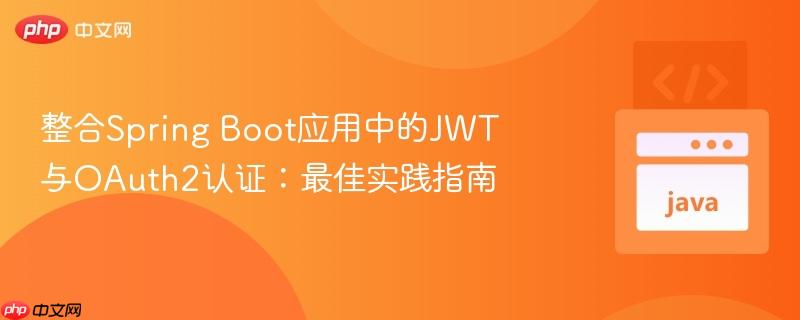
在构建需要支持多种认证方式(如用户名/密码登录和社交媒体登录)的spring boot应用时,开发者常会面临如何同时处理jwt和oauth2的挑战。一个常见的误区是尝试在spring boot应用内部独立实现这两种认证机制。然而,更专业、安全且可扩展的方案是利用专门的oauth2/openid授权服务器(authorization server)来统一管理所有用户认证和令牌发放。
授权服务器的核心作用是作为身份验证的中心枢纽,它负责:
选择一个成熟的授权服务器,如Keycloak(开源自部署)、Auth0、Amazon Cognito(云服务),能够极大地简化开发工作,并确保遵循行业最佳实践和安全标准。
当授权服务器负责了用户认证和令牌发放后,我们的Spring Boot应用的角色就变得清晰起来:它是一个资源服务器(Resource Server)。资源服务器的唯一职责是保护其提供的API资源,并根据传入请求中的访问令牌来验证用户身份和授权。它不再需要关心用户如何登录,也不需要存储用户凭据。
配置Spring Boot应用作为资源服务器,主要涉及Spring Security的配置,使其能够解析和验证由授权服务器签发的JWT令牌。
示例代码:配置Spring Boot作为OAuth2资源服务器
在application.yml或application.properties中,配置授权服务器的元数据URI:
spring:
security:
oauth2:
resourceserver:
jwt:
# 授权服务器的JWK Set URI,Spring Security将从这里获取公钥来验证JWT签名
jwk-set-uri: http://localhost:8080/realms/your-realm/protocol/openid-connect/certs
# 授权服务器的Issuer URI,用于验证JWT的iss字段
issuer-uri: http://localhost:8080/realms/your-realm然后,在Spring Security配置类中,启用OAuth2资源服务器:
import org.springframework.context.annotation.Bean;
import org.springframework.context.annotation.Configuration;
import org.springframework.security.config.annotation.web.builders.HttpSecurity;
import org.springframework.security.config.annotation.web.configuration.EnableWebSecurity;
import org.springframework.security.web.SecurityFilterChain;
@Configuration
@EnableWebSecurity
public class SecurityConfig {
@Bean
public SecurityFilterChain securityFilterChain(HttpSecurity http) throws Exception {
http
.authorizeHttpRequests(authorizeRequests ->
authorizeRequests
.requestMatchers("/public/**").permitAll() // 允许公共访问
.anyRequest().authenticated() // 其他所有请求都需要认证
)
.oauth2ResourceServer(oauth2ResourceServer ->
oauth2ResourceServer.jwt(jwt -> {}) // 启用JWT资源服务器
);
return http.build();
}
}通过这种配置,Spring Boot应用会自动从jwk-set-uri获取公钥,并使用issuer-uri验证传入JWT的有效性。一旦JWT被验证通过,Spring Security会根据令牌中的信息(如scope或自定义声明)构建认证对象,供后续的授权决策使用。
前端用户界面(UI)是客户端(Client),它负责引导用户到授权服务器进行认证,获取访问令牌,然后使用这些令牌向资源服务器(我们的Spring Boot应用)发送请求。
根据UI的类型,有不同的处理方式:
纯浏览器端应用(SPA,如Angular/React):
服务器端渲染(SSR)或BFF(Backend For Frontend)模式:
示例代码:BFF模式下Spring Boot作为OAuth2客户端(概念性)
// 在BFF应用的application.yml中
spring:
security:
oauth2:
client:
registration:
your-auth-server: # 注册一个OAuth2客户端
client-id: your-client-id
client-secret: your-client-secret
authorization-grant-type: authorization_code
redirect-uri: "{baseUrl}/login/oauth2/code/{registrationId}"
scope: openid, profile, email
provider:
your-auth-server: # 配置授权服务器信息
issuer-uri: http://localhost:8080/realms/your-realm通过采纳这种架构,开发者可以构建出既安全又易于维护的Spring Boot应用,有效地应对多样化的用户认证需求。避免在应用内部重复造轮子,而是利用行业标准和成熟解决方案,将是构建健壮系统的关键。
以上就是整合Spring Boot应用中的JWT与OAuth2认证:最佳实践指南的详细内容,更多请关注php中文网其它相关文章!

每个人都需要一台速度更快、更稳定的 PC。随着时间的推移,垃圾文件、旧注册表数据和不必要的后台进程会占用资源并降低性能。幸运的是,许多工具可以让 Windows 保持平稳运行。

Copyright 2014-2025 https://www.php.cn/ All Rights Reserved | php.cn | 湘ICP备2023035733号